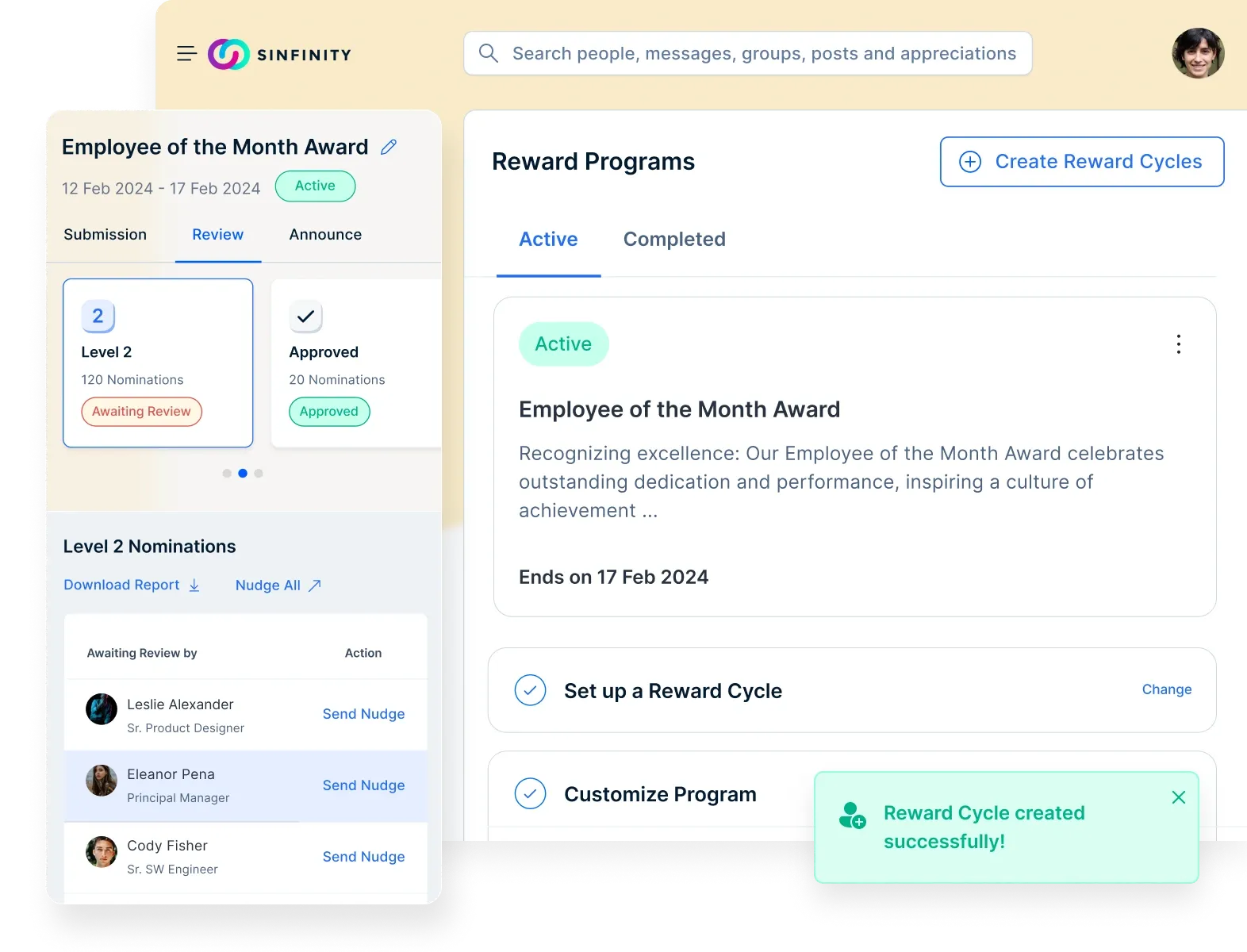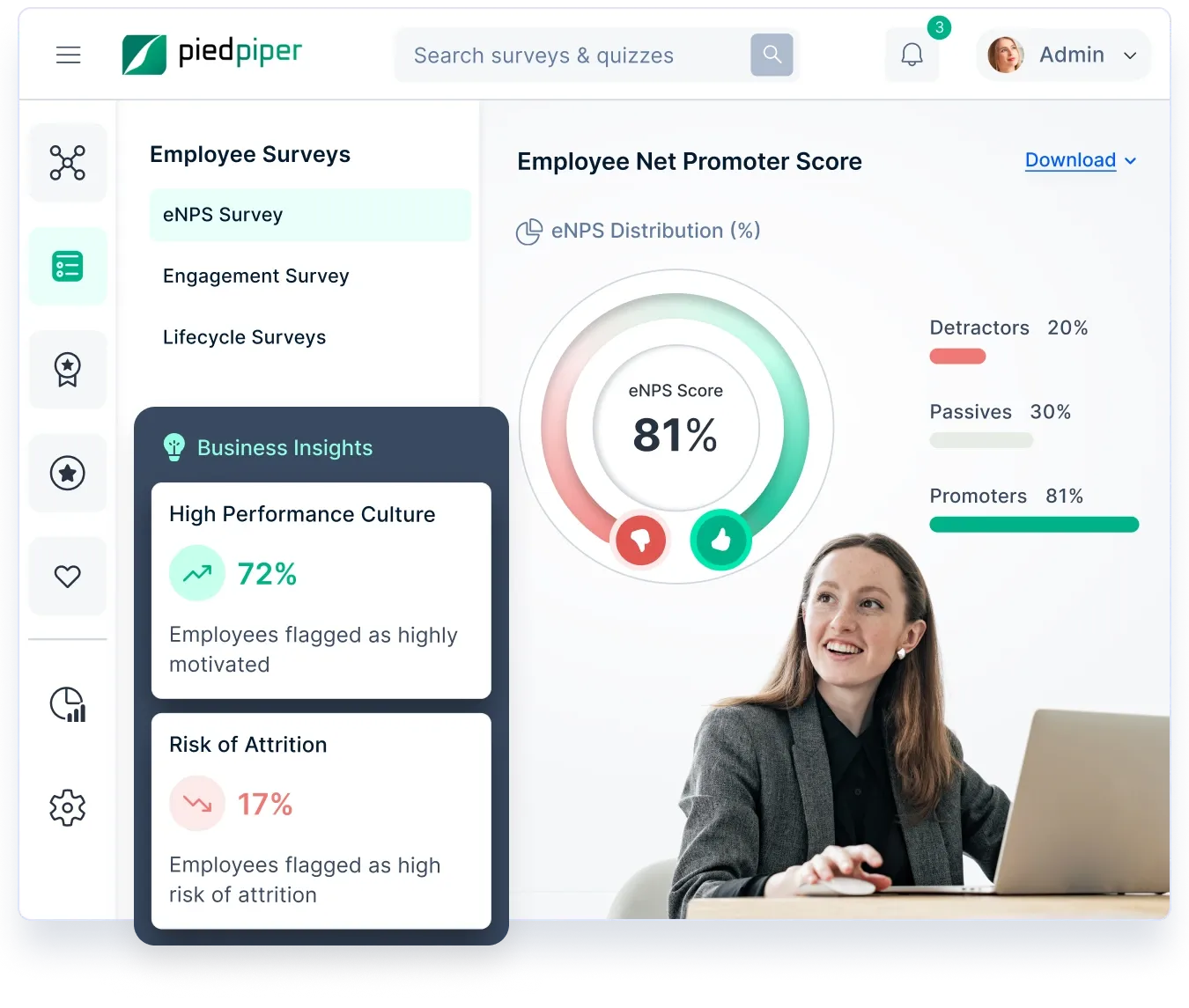Employee Disengagement: Impact, Causes and Ways to Re-Engage Disengaged Employees
Employee disengagement affects productivity, morale, and retention. Re-engagement requires more than quick fixes—it’s about fostering a culture where employees feel valued, connected, and motivated.
Di halaman ini
Workplaces thrive when employees feel engaged, motivated, and valued. But what happens when that spark fades? Employee disengagement is a silent killer of productivity, innovation, and retention. When employees feel disconnected from their work, they do the bare minimum, look for new opportunities, or mentally check out entirely.
Even top-performing companies recognize this challenge. Google, for instance, tackled disengagement by giving employees creative freedom through its “20% time” policy, leading to groundbreaking innovations like Gmail and AdSense.
Similarly, Walmart and Target invest in educational subsidies to retain talent and motivate employees. These initiatives prove that engagement levels rise when businesses invest in their people, and so does overall success.
But not every company takes proactive measures, and the cost of disengagement is steep—lower productivity, higher turnover, and a toxic workplace culture. In this blog, we’ll break down the stages of disengagement, how it affects businesses, and what you can do to prevent it before it’s too late.
What is employee disengagement?
Employee disengagement happens when workers lose connection to their job, team, or the company’s goals. Instead of feeling motivated and invested, they go through the motions, doing only what’s necessary. This lack of enthusiasm affects productivity, collaboration, and overall workplace morale.
Disengagement isn’t always evident at first. Some employees may still show up on time and complete their tasks but without energy or commitment. Others might openly express frustration, avoid responsibilities, or seek new opportunities. Over time, disengagement spreads, leading to lower performance, higher turnover, and a hostile work environment.
The stages of employee disengagement
Employee disengagement doesn’t happen overnight. It’s a gradual process where enthusiasm fades, motivation declines, and productivity takes a hit. Understanding the stages of disengagement can help businesses identify warning signs early and take action before employees thoroughly check out. Here’s how disengagement typically unfolds:
Stage 1: Initial discontent
At this stage, employees experience mild dissatisfaction. They may feel unappreciated, bored, or disconnected from their work but still put in effort. Signs include subtle changes in attitude, a lack of enthusiasm, and reduced participation in team activities.
Stage 2: Declining commitment
Discontent turns into disengagement as employees lose their emotional connection to the company. They might put in the minimum effort, avoid extra responsibilities, and show less interest in company goals. This is when absenteeism and decreased productivity start becoming noticeable.
Stage 3: Active withdrawal
By this point, employees mentally check out. They contribute only, when necessary, avoid collaboration, and may even express negativity about their work or colleagues. They might frequently call in sick, arrive late, or leave early. Burnout, frustration, and resentment often build up at this stage.
Stage 4: Full disengagement
Employees reach a point where they no longer care about their work or the company’s success. They might openly criticize management, ignore deadlines, and show no initiative. At this stage, they are either looking for another job or waiting to be let go.
Stage 5: Separation
The final stage is either voluntary or involuntary exit. The employee resigns or is terminated due to poor performance and a lack of commitment. If the underlying issues are not addressed, businesses risk losing more employees to disengagement.
Recognizing these stages early allows companies to take proactive steps—offering support, improving communication, and re-engaging employees before it’s too late.
Impact of employee disengagement
Employee disengagement affects more than individual performance—it disrupts teams, lowers morale, and harms business success. When employees lose motivation, the ripple effects can be costly.
- Lower productivity – Disengaged employees put in minimal effort, leading to slower workflows, missed deadlines, and reduced team efficiency. Tasks that should take hours end up stretching over days.
- Higher turnover rates – Employees who feel disconnected from their work or unappreciated start looking for new opportunities. Increased turnover leads to hiring and training costs, putting additional strain on the remaining workforce.
- Poor customer experience – Disengaged employees lack enthusiasm in their interactions with customers. This leads to poor service, lower satisfaction, and potential damage to brand reputation.
- Increased absenteeism – A lack of motivation often results in frequent sick days or unexplained absences. Teams struggle with an uneven workload, further impacting morale and overall output.
- Negative workplace culture – When disengagement spreads, it creates a toxic work environment. Unmotivated employees drain the energy of those around them, leading to resentment, frustration, and declining team spirit.
- Financial losses – Businesses dealing with disengaged employees face higher operational costs, whether from lost productivity, recruitment expenses, or decreased customer retention. Studies show that disengagement can cost companies thousands of dollars per employee each year.
Ignoring disengagement comes at a steep price. Addressing it early helps businesses maintain a motivated workforce, improve retention, and foster a work environment where employees feel valued and driven to perform.
Penyebab utama pelepasan karyawan
Employees are the backbone of any organization. When they feel engaged and motivated, they contribute their best efforts, leading to increased productivity, innovation, and success for the company.
However, a growing concern in today's workplace is employee disengagement. This section will delve into the key factors contributing to this phenomenon and explore ways to address them.
1. Kurangnya tujuan dan makna
Imagine a mechanic who meticulously replaces car parts every day but never understands how those parts work together to create a functioning vehicle. This feeling of isolation from the bigger picture is a common cause of disengagement.
Employees who don't understand how their daily tasks contribute to the company's mission or overall goals often feel like cogs in a machine, replaceable and unimportant.
Hal ini dapat disebabkan oleh:
Unclear company vision: Companies with a weak or poorly communicated vision statement fail to inspire employees. When employees don't understand the company's "why," it's hard to feel passionate about the "what" they do each day.
Disconnection between individual tasks and overall goals: Employees need to see how their specific role fits into the bigger picture. Breaking down company goals into smaller, team-oriented objectives and regularly communicating progress can help bridge this gap.
2. Manajemen yang buruk
Kepemimpinan yang tidak efektif adalah kontributor signifikan terhadap ketidakpuasan karyawan. Manajer yang mengatur secara mikro yang mengawasi karyawan, menghambat kreativitas, dan menawarkan sedikit atau bahkan tidak ada otonomi dengan cepat menguras motivasi. Demikian pula, kurangnya komunikasi, ekspektasi yang tidak jelas, dan pilih kasih dapat menciptakan lingkungan kerja yang membuat frustasi dan menurunkan motivasi.
The importance of supportive management: Employees thrive under supportive managers who provide clear direction, regular feedback (both positive and constructive), and opportunities for growth.
Effective managers invest time in getting to know their team members, understand their strengths and weaknesses, and offer guidance for professional development.
3. Pertumbuhan dan perkembangan yang terbatas
Karyawan yang merasa tidak ada kesempatan untuk belajar, berkembang, atau maju dengan cepat kehilangan motivasi. Perusahaan yang gagal menawarkan program pelatihan, peluang bimbingan, atau jalur karier yang jelas berisiko kehilangan talenta yang berharga.
Investing in employee development: By offering learning and development opportunities, companies demonstrate their commitment to their employees' long-term growth and success.
This increases employee engagement and equips them with the skills necessary to excel in their roles and contribute more effectively to the company's goals.
4. Kompensasi dan tunjangan yang tidak kompetitif
Feeling undervalued financially can be a major demotivator. Employees who are consistently paid below market value or offered inadequate benefits packages may feel resentful and disengaged.
Competitive compensation matters: Offering competitive salaries and benefits packages that reflect employee contributions and market value is crucial for attracting and retaining top talent.
Additionally, non-monetary benefits like work-life balance programs, healthcare options, and opportunities for flexible work arrangements can significantly improve employee well-being and satisfaction.
5. Beban kerja yang berlebihan dan stres
Merasa terus menerus terbebani dan stres adalah resep untuk kelelahan dan ketidakpuasan. Beban kerja yang berlebihan, tenggat waktu yang tidak realistis, dan kurangnya keseimbangan antara pekerjaan dan kehidupan pribadi dapat dengan cepat menguras energi dan motivasi karyawan.
Promoting healthy work practices: Companies are responsible for promoting healthy work practices by ensuring workloads are manageable, deadlines are reasonable, and employees have opportunities to disconnect and recharge outside of work hours. Tools like Empuls can play a role in streamlining workflows, automating tasks, and ultimately reducing employee stress.
6. Lingkungan kerja yang tidak sehat
Lingkungan kerja yang beracun yang ditandai dengan komunikasi yang buruk, kurangnya kolaborasi, atau budaya ketakutan dapat membuat karyawan menjauh. Hal-hal negatif yang terus menerus, gosip, intimidasi, atau kurangnya rasa hormat dapat menciptakan suasana kerja yang menegangkan dan tidak menyenangkan.
Importance of a positive work environment: Fostering a positive, respectful, and inclusive work environment is essential for employee engagement. When employees feel valued, appreciated, and supported by their colleagues and managers, they are more likely to be motivated, productive, and committed to the company's success.
How to re-engage disengaged employees?
When employees check out emotionally, productivity drops, workplace morale suffers, and turnover increases. Re-engagement requires more than just surface-level solutions—it involves creating an environment where employees feel valued, connected, and motivated to contribute. Here’s how to bring disengaged employees back on track:
1. Recognize and reward contributions
Feeling unappreciated is one of the main reasons employees disengage. People want their hard work to be noticed and valued. Implementing a structured rewards and recognition program like Empuls helps create a culture where employees receive timely appreciation for their contributions.
Recognition doesn’t always have to be monetary; it can be as simple as a peer shoutout, a digital badge, or a personalized note from leadership. When employees feel that their efforts matter, they are more likely to stay motivated and engaged.
2. Foster open communication and feedback
Employees disengage when they feel unheard or disconnected from company goals. Open and transparent communication helps rebuild trust and involvement. Regular check-ins, town halls, and feedback sessions allow employees to voice their concerns and feel part of the bigger picture.
Using a platform like Empuls' employee survey tool makes it easier to gather real-time insights on engagement levels. Surveys provide a structured way to understand employee sentiment, identify disengagement triggers, and implement meaningful changes based on their feedback.
3. Menawarkan fasilitas dan manfaat yang berarti
Employees seek more than just a paycheck—they want to feel supported in different aspects of their lives. A well-thought-out benefits package shows employees that their well-being is a priority.
Offering tax-free fringe benefits through Empuls allows companies to provide personalized perks, such as wellness stipends, learning allowances, or commuter benefits.
Customized benefits make employees feel cared for, reinforcing their connection to the company and reducing disengagement. Small but meaningful perks often have a significant impact on retention and motivation.
4. Strengthen workplace connections
Disengaged employees often feel isolated from their teams. Encouraging social interactions, collaboration, and bonding activities helps employees feel like they belong. Empuls' social intranet software facilitates stronger workplace connections, whether employees are remote, hybrid, or in-office.
A digital community where employees can engage in casual conversations, celebrate milestones, and collaborate beyond work tasks fosters a sense of belonging. Employees who feel connected to their colleagues are more likely to stay engaged and motivated.
5. Provide career growth and development opportunities
A lack of career growth often leads employees to disengage. If they feel stuck in a role with no room for advancement, motivation declines. Offering career development opportunities, mentorship programs, and upskilling initiatives gives employees a reason to stay invested in their work.
Encouraging internal mobility, setting clear career paths, and providing leadership training programs help employees see a future within the company. When employees feel they have room to grow, they become more engaged and committed to their roles.
6. Prioritize work-life balance
Burnout is one of the biggest contributors to disengagement. Employees who feel overworked and stressed become less productive and more likely to mentally check out. Encouraging flexible work arrangements, reasonable workloads, and mental health initiatives helps prevent burnout and keeps employees engaged.
Companies that promote work-life balance see higher retention and productivity. Simple changes, such as offering remote work options, wellness programs, or encouraging employees to take breaks, create a healthier work environment that fosters long-term engagement.
Turning employee disengagement into engagement with Empuls
Employee disengagement isn't just about lack of motivation; it's about feeling unseen, unheard, and undervalued. Empuls addresses these issues head-on by transforming workplace culture into one that thrives on appreciation, connection, and well-being.
- Recognition that feels genuine
A simple ‘thank you’ isn’t enough. Empuls weaves appreciation into the daily workflow, ensuring achievements—big or small—are celebrated in meaningful ways.

- Rewards that resonate

Generic rewards miss the mark. Empuls personalizes milestone rewards and perks, making every incentive feel exclusive and valuable to the employee receiving it.
- Surveys that give employees a voice

Engagement starts with listening. Empuls’ employee survey tool captures real insights, helping organizations understand what truly drives their teams.
- A Social intranet that builds community

Disconnection fuels disengagement. Empuls' social intranet fosters open conversations, keeping employees informed, engaged, and aligned with company goals.
- Fringe benefits that matter

Perks shouldn't feel like a checkbox exercise. Empuls curates tax-free fringe benefits that enhance employees’ financial well-being and overall job satisfaction.
Instead of patchwork solutions, Empuls offers an all-in-one platform designed to eliminate disengagement at its root. It’s not just about making work better—it’s about making employees feel like they belong, every single day.
With Empuls, you can build a culture where employees feel valued, connected, and motivated to give their best. Ready to transform your workplace? Explore Empuls today!
Kesimpulan
Disengaged employees are a drain on any organization. But we can unlock their true potential by prioritizing their well-being and fostering a culture of purpose, growth, and inclusivity.
Employee disengagement isn't inevitable – it's a challenge we can overcome. Your employees are your greatest asset. Invest in them, empower them. By leveraging Empuls effectively and implementing a holistic employee engagement strategy, you can create a more motivated, productive, and satisfied workforce. Contact our employee engagement and culture experts for a free demo.
Pertanyaan Umum
1. How does employee disengagement impact attrition?
Disengaged employees feel unmotivated and disconnected, making them more likely to seek new job opportunities, leading to higher turnover rates.
2. How does employee disengagement influence productivity?
Disengaged employees put in minimal effort, miss deadlines, and contribute less to team goals, lowering overall efficiency and output.
3. What causes employee disengagement?
Common causes include lack of recognition, limited growth opportunities, poor leadership, work-life imbalance, and unclear expectations.













